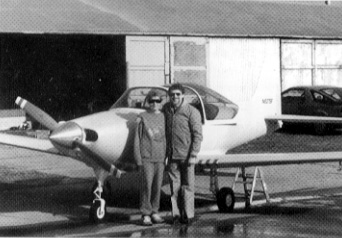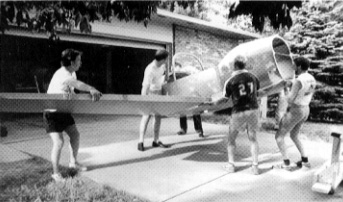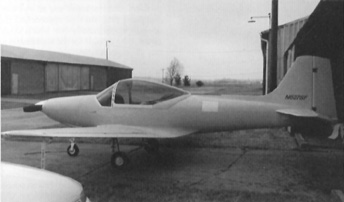First Flight:
Jim Petty
![]()
First Flight:
|
|
by Alfred Scott
This article appeared in the March 1995 issue of the Falco Builders Letter. |

Proud parents after the first flight, Rita and Jim Petty.
Years ago, I received a call from my lawyer. He wanted me to meet with a friend of his, Hunter Taylor, who had just moved to town and who had once worked at Lockheed on the C-5A. When Hunter arrived, I was in the process of laying out the shape of the instrument panel using the old geometric method of drawing a series of lines.
"What are you doing?" he asked. "Laying out an ellipse," said I. "My God, that method went out with the Egyptians!" said Hunter, who went on to explain that there is a formula for an ellipse and that you could crank out the points on the curve with a programmable calculator. I thought that was great, and asked Hunter to send it to me.
After the equation arrived, I put all the necessary steps into my calculator and cranked out the points. I went into shock. The points were way off from the curve I had drawn, and I lay awake all night in fear that all of the fuselage frame shapes were wrong. The next day, I finally proved that the shape of the fuselage frame was, in fact, not an ellipse at all, but a completely different shape. I did this by constructing the curve from two equal-length sides, and the proof fell in the fact that the shape was not a circular arc.
But I became intrigued with the idea of generating the fuselage shapes accurately from a formula (something I can now do in a few seconds in my CAD program), and I tried to interest mathematically-minded friends into solving the Falco fuselage curve problem. Everyone always said, "That looks pretty simple", and then gave up after a few days. Hunter Taylor would always go into this big song-and-dance about how he took all of the most advanced math courses in engineering school, and how understanding the concept was more important than knowing the answer, but he never actually produced an equation I could use.
I tried another friend, a college math professor, who always argued with me about why I would want to know this or that. John Oliver got his son interested in the problem, and the result was an awkward computer program that approached the answer incrementally but which could never solve directly for the coordinates at any given point.
It was clearly a difficult problem, and one day I called Jim Petty to see if I could interest him in working on the problem. "Oh yeah, that is pretty difficult," said Jim. "I solved that the other day, and it took about 30 minutes. I've got the formula somewhere."
That was my first inkling of what sort of grey matter resided between Jim Petty's ears. Since then I've called Jim on countless occasions with a math problem. Our Benchmark performance testing program is entirely built around Jim's equations, and one of the leading CAD programs on the Macintosh is filled with his equations-even though Jim has never even seen the program and doesn't use a Mac!
Jim has a PhD in aeronautical engineering and worked at the Air Force's Wright-Patterson Research center in Dayton. He has worked in hypersonic flow and on turbine engines for the last 17 years. Some of the engine work was on solving problems with the F-100 engine and others in the field, but most of it was R&D work toward the future. He was the first program manager for the F-119, the engine used in the new stealthy F.22 advanced tactical fighter. Jim worked in the part of Wright-Patterson that is now called the Wright Laboratory, which at its peak employed 2500 people and had an annual budget of over $500 million.

Jim (far right) and friends roll the Falco over during construction.
Jim was also a member of the base aero club, where he flew T-34's. His plan was to buy an airplane when he retired, but when we came out with the Falco, Jim had to build one. "I had been a Falco admirer since the mid-50's," he said, and he just had to have a Falco.
Jim ordered his plans in 1980 and began the process of building right away, but he was never in a hurry. He took his time and decided from the beginning to really not push on the construction. For one thing, he wanted to be careful that he didn't burn out, and also he was quite busy at work. There were a couple of years when he didn't do anything on the plane, but finally he retired 1-1/2 years ago and since then he's got busy on the Falco. On February 17, he finally got the Falco in the air-14 years and two months after he started.
But before we get into the Falco, lemme tell you something about the other half of the Petty family. Rita Petty is, in my book, every bit as remarkable and special as Jim. She worked as a medical technologist at the Children's hospital, and then got a masters degree in biology and worked in research.
It's always the quiet people who surprise you, and you'd never guess from the soft voice on the telephone what Rita is really made of. She's a physical fitness freak, and started running in the late 70's. Rita likes to compete in marathons and 'iron man' triathelons, and they have a wall full of plaques and awards. And if that's not impressive enough, consider this: for the last ten years Rita's been fighting cancer. She's already reached her lifetime doses on most of the drugs and continued to compete in marathons and triathelons while going through chemo. Sheesh!
Back to the Falco, it has a 160 hp IO-320-B1A which Jim got from Don George about a year ago. The plane weighs 1,273 lbs empty with a 68.5" CG. The panel has a Narco Mark 12D+, Narco transponder, engine analyzer and a hand-held GPS.
It's a perfectly conventional Falco, distinguished only by a slightly longer wing fillet than normal. Jim said the fillet didn't seem right so he extended it back about 5-6 inches beyond the fuselage break line. Jim originally planned to install full wheel well doors, but after hearing about the difficulties others were having, he changed his mind.

Steve Bachnak flew his Falco to Dayton and gave Jim a couple of hours in his plane. Jim said this was a big help and he had no difficulty on the first flight, which lasted for 40 minutes and was flown with the gear down. The airplane has required a trim tab on the rudder and may yet end up with a tab on one aileron. Jim flew the first 25 hours off in 28 days and in that process flew the Falco to the red line, pulled 4.5 g's and rolled it a few times.
Jim says the Falco flies well. "It is the easiest plane I've ever flown." It's a lot better handling tht the T-34, and so far he's only messed up one landing in which he touched down too fast. The roll rate is 90° a second, and the plane's maximum speed is right at 200 mph. Jim thinks he will get another 5 mph when he installs the hinge fairings.
Thus far the problems with the plane have been minimal. In the early part of January, the Falco fell off a jack, which punched a hole in the bottom of the wing. Fortunately, it was easy to fix and did no permanent damage. Right now the circuit breaker pops when the gear is retracted in the air, yet it works perfectly on the ground. Jim doesn't yet understand why this is happening, and he also has a mysterious problem with short-period rpm changes of about 30 rpm over 2 seconds above 2400 rpm.
The Falco is in gray primer and the interior is unfinished, but Jim is starting to talk to people about painting it now. By all accounts, N627SF is an immaculate airplane. Congratulations to Jim and Rita on getting the 45th Sequoia Falco into the air.